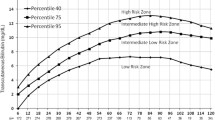Abstract
Objective
To determine the first day total serum bilirubin (TSB) value which will predict with reasonable accuracy, neonates likely to develop subsequent significant hyperbilirubinemia.
Methods
Serum bilirubin was estimated for all enrolled cases within 18 to 30 hr of life by microcapillary. The babies were then followed up clinically by 2 observers for the appearance and progression of jaundice every 12 hr till discharge and then daily upto fifth day of life. TSB estimation was repeated if the clinical assessment of jaundice was more than 10 mg/dl by any observer using Kramers Rule. Hyerbilirubinemia was defined as TSB level ≥12 mg/dl between 24 to 48 hr of life ≥15 mg/dl between 48 to 72 hr of life and 17 mg/dl beyond 72 hours of life.
Results
A total of 200 neonates were enrolled in the study. Of these, 24 neonates (i.e., 12%) developed hyperbilirubinemia. The mean first day TSB value in the neonates who subsequently developed hyperbilirubinemia was 7.716 mg/dl as compared to a value of 5.154 mg/dl in those who did not. The difference was significant (p=0.000). Using Receiver operating characteristic (ROC) curve analysis, a value of 6.4 mg/dl (first day TSB) was determined to have the best predictive ability for subsequent hyperbilirubinemia with a sensitivity of 87.5%, specificity of 80.11%, positive predictive value of 37.5% and a negative predictive value of 97.92%.
Conclusion
First day TSB estimation can serve as a reliable screening test for neonates at risk for subsequent hyperbilirubinemia. Neonates with the first day TSB level of less than 6.4 mg/dl have minimum risk of subsequent hyperbilirubinemia.
Similar content being viewed by others
Abbreviations
- TSB:
-
Total serum bilirubin
- PPV:
-
Positive predictive value
- NPV:
-
Negative predictive value
References
Macmohan JR, Stevenson DK, Oski FA. Physiologic Jaundice. In William TH, Robert AB, eds. Avery’s diseases of the newborn, 7th ed. Singapore; Harcourt Asia private limited, 1998: 1003.
Maisels MJ, Kring E. Length of stay, jaundice and hospital readmission. Pediatrics 1998;101: 995–998.
Hall RT, Simon S, Smith MT. Readmission of breast fed infants in the first two weeks of life. J Perinatol 2000;20:432–437.
American academy of Pediatrics Provisional Committee for Quality Improvement and Subcommittee on Hyperbilirubinemia. Practice parameter: Management of Hyperbilirubinemia in the healthy term newborns. Pediatrics 1994; 94: 558–565.
Kramer LI. Advancement of dermal icterus in the jaundiced newborn. Amer J Dis Child 1969;118: 454–458.
Seidman DS, Zivanit E, Paz I, Laor A, Revel-Vilk S, Stevenson DK et al. Predicting the risk of jaundice in full-term healthy newborns: A prospective population based study. J Perinatology 1999; 19: 564–567.
Bhutani VK, Johnson L, Sivieri EM. Predictive ability of predischarge hour specific serum bilirubin for subsequent significant hyperbilurubinemia in healthy term and nearterm newborns. Pediatrics 1999;103:6–14.
Tape TM. Interpreting diagnostic tests. University of Nebraska Medical Centre [10 screens]. Available from: http://gim.unmc.edu/dxtests/Default.htm. Accessed September 16, 2004.
Alpay F, Sarici U, Tosuncuk H, Serdar MA, Inanc N, Gokcay E. The value of first-day bilirubin measurement in predicting the development of significant hyperbilirubinemia in healthy term newborns. Pediatrics 2000;106:e16.
Awasthi S, Rehman H. Early prediction of neonatal hyperbilirubinemia. Indian J Pediatr 1998; 65: 131–139.
Agarwal R, Kaushal M, Agarwal R, Paul VK, Deorari AK. Early neonatal hyperbilirubineamia using first day serum bilirubin level. Indian Pediatrics 1997; 34: 429–432.
Author information
Authors and Affiliations
Corresponding author
Rights and permissions
About this article
Cite this article
Randev, S., Grover, N. Predicting neonatal hyperbilirubinemia using first day serum bilirubin levels. Indian J Pediatr 77, 147–150 (2010). https://doi.org/10.1007/s12098-009-0335-3
Received:
Accepted:
Published:
Issue Date:
DOI: https://doi.org/10.1007/s12098-009-0335-3



